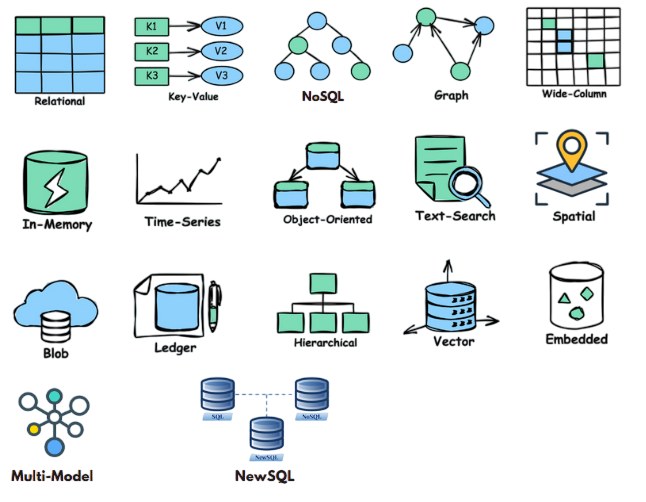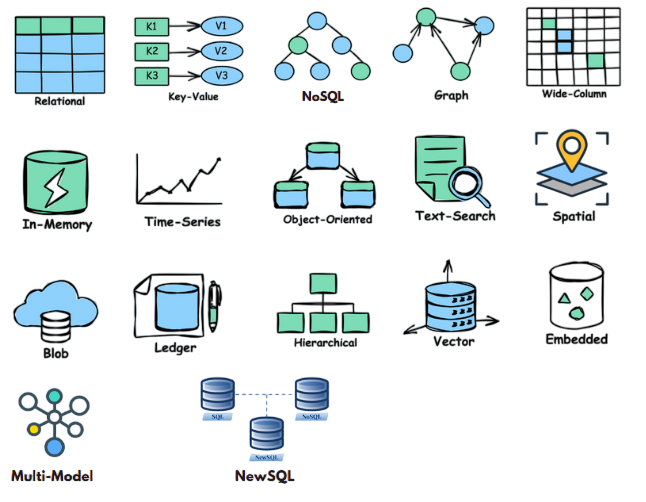- Last updated: 03 Jun, 2025
Databases form the backbone of modern applications, storing and managing the data that powers everything from small blogs to massive enterprise systems. However, choosing the right type of database for a project can be daunting due to the wide variety of options available. This article explores the major types of databases and provides guidance on when to use them.

1. Relational Databases (RDBMS)
Definition: Relational databases organize data into tables (rows and columns) and use structured query language (SQL) for querying and managing data.
Examples: MySQL, PostgreSQL, Oracle Database, Microsoft SQL Server
Key Features:
ACID compliance ensures data reliability and integrity.
Supports complex queries and relationships between data.
When to Use:
Applications requiring strong data consistency, such as financial systems or inventory management.
Scenarios where data relationships are well-defined, such as CRM systems or e-commerce platforms.
2. NoSQL Databases
Definition: NoSQL databases are designed for unstructured or semi-structured data and offer flexibility in data modeling.
Types of NoSQL Databases:
Document Stores: MongoDB, Couchbase
Key-Value Stores: Redis, DynamoDB
Columnar Databases: Apache Cassandra, HBase
Graph Databases: Neo4j, Amazon Neptune
Key Features:
Schema-less design allows for flexible data structures.
Optimized for scalability and high performance.
When to Use:
Applications with rapidly changing or diverse data structures, such as social media platforms or content management systems.
Scenarios requiring high scalability and fast read/write operations, like real-time analytics or IoT data storage.
Use graph databases for data with complex relationships, like recommendation engines or social networks.
3. In-Memory Databases
Definition: In-memory databases store data in RAM instead of disk, enabling ultra-fast data access.
Examples: Redis, Memcached
Key Features:
Extremely low latency.
Ideal for caching and real-time data processing.
When to Use:
Caching frequently accessed data to improve application performance.
Real-time analytics and high-frequency trading systems.
Session storage in web applications.
4. Time-Series Databases
Definition: Time-series databases are optimized for handling time-stamped data.
Examples: InfluxDB, TimescaleDB
Key Features:
Specialized querying for time-series data.
Efficient storage of large volumes of time-stamped data.
When to Use:
Monitoring and observability systems, such as server performance metrics or application logs.
IoT applications collecting sensor data.
5. Object-Oriented Databases
Definition: Object-oriented databases store data as objects, similar to how data is represented in object-oriented programming.
Examples: ObjectDB, db4o
Key Features:
Tight integration with object-oriented programming languages.
Supports inheritance, polymorphism, and encapsulation.
When to Use:
Applications with complex data models and relationships that align with object-oriented principles, such as simulations or multimedia systems.
6. Graph Databases
Definition: Graph databases focus on relationships between data points, representing data as nodes, edges, and properties.
Examples: Neo4j, Amazon Neptune
Key Features:
Highly efficient for querying complex relationships.
Supports graph-specific algorithms like shortest path and clustering.
When to Use:
Applications involving interconnected data, such as social networks, fraud detection, and recommendation systems.
7. NewSQL Databases
Definition: NewSQL databases combine the scalability of NoSQL with the ACID compliance of relational databases.
Examples: Google Spanner, CockroachDB
Key Features:
Horizontal scalability.
Maintains strong consistency.
When to Use:
Applications requiring the reliability of relational databases with the scalability of NoSQL, such as global e-commerce platforms or distributed applications.
8. Multi-Model Databases
Definition: Multi-model databases support multiple data models (e.g., document, key-value, graph) within a single database engine.
Examples: ArangoDB, MarkLogic
Key Features:
Flexibility to handle diverse data types.
Reduces the need for multiple databases.
When to Use:
Projects requiring diverse data storage needs.
Simplifying architecture by consolidating multiple database types.
9. Embedded Databases
Definition: Embedded databases are lightweight databases integrated directly into applications.
Examples: SQLite, H2
Key Features:
Minimal setup and maintenance.
Runs within the application process.
When to Use:
Mobile applications or lightweight desktop software.
Applications with limited database size and simple data needs.
10. Hierarchical Databases
Definition: Hierarchical databases organize data in a tree-like structure, with parent-child relationships.
Examples: IBM IMS
Key Features:
Fast access for hierarchical data.
Simplified data navigation in predefined structures.
When to Use:
Applications with well-defined parent-child relationships, such as file systems or directory structures.
11. Vector Databases
Definition: Vector databases are optimized for storing and querying vector embeddings, often used in AI and machine learning.
Examples: Pinecone, Weaviate
Key Features:
Efficient similarity searches.
Supports machine learning and AI workloads.
When to Use:
Applications like recommendation systems, image or document similarity searches, and AI model serving.
12. Ledger Databases
Definition: Ledger databases provide immutable and cryptographically verifiable transaction logs.
Examples: Amazon QLDB
Key Features:
Immutable data storage.
Verifiable transaction history.
When to Use:
Applications requiring auditable transaction records, such as financial systems or supply chain management.
13. Blob Databases
Definition: Blob databases are designed for storing binary large objects (BLOBs) like images, videos, or files.
Examples: Azure Blob Storage, Amazon S3
Key Features:
Efficient storage and retrieval of large files.
High scalability and durability.
When to Use:
Applications storing large unstructured data, such as multimedia or backups.
14. Spatial Databases
Definition: Spatial databases are optimized for storing and querying spatial data, such as geographic coordinates.
Examples: PostGIS, Oracle Spatial
Key Features:
Specialized indexing for spatial queries.
Supports geographic and geometric data types.
When to Use:
GIS systems, location-based services, or mapping applications.
15. Text Search Databases
Definition: Text search databases are designed for full-text search and indexing.
Examples: Elasticsearch, Solr
Key Features:
High performance for text search queries.
Supports advanced querying and text analysis.
When to Use:
Applications requiring powerful search capabilities, such as search engines or document management systems.
16. Wide Column Stores
Definition: Wide column stores use a tabular format but allow for flexible column definitions for each row.
Examples: Apache Cassandra, HBase
Key Features:
High write and read performance.
Optimized for large-scale data storage.
When to Use:
Applications with high scalability needs, such as time-series data or logging.
17. Key-Value Stores
Definition: Key-value stores store data as key-value pairs.
Examples: Redis, DynamoDB
Key Features:
Simple and fast lookups.
High performance for key-based queries.
When to Use:
Caching, session storage, or configurations.
Applications requiring low-latency data access.
Conclusion
Selecting the right database is critical for achieving optimal performance, scalability, and reliability in your applications. Relational databases remain a solid choice for structured data and well-defined relationships, while NoSQL databases excel in scenarios requiring flexibility and scalability. Specialized databases like in-memory, time-series, graph, and others cater to specific use cases. Understanding the strengths and trade-offs of each type will empower you to make informed decisions and build robust, efficient systems tailored to your needs.
Similar Post
Exploring Database Types: A Guide to Choosing the Right Solution
- 04 Jun, 2025
- 5 min read
This guide explores the different types of databases and provides insights into the ideal situations for using each one.

